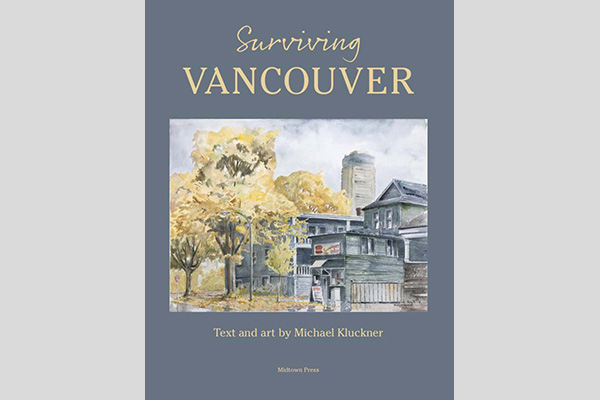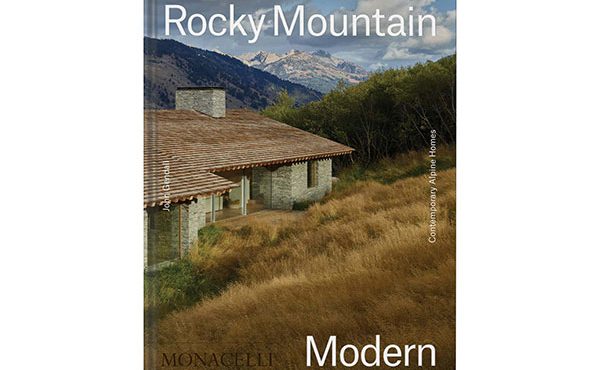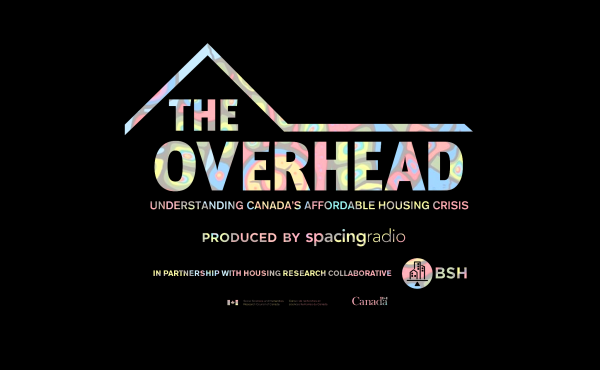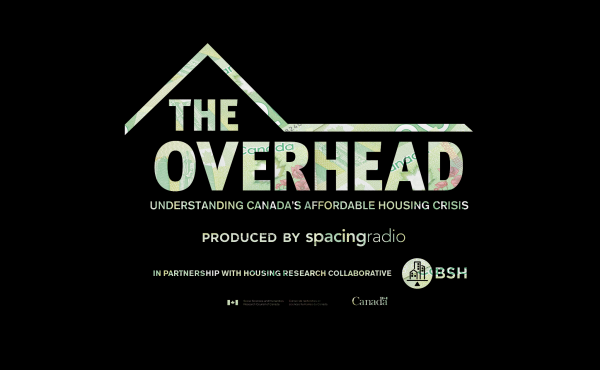
“There’s a tranquil spot at Georgina Point on Mayne Island where I sat in 2021 and looked back across the Salish Sea to the mainland. It was a clear day, the north shore mountains and the towers of Vancouver faintly visible in the left distance but so far away as to be just a memory. As I painted, the water lapped against the rocks and a seal swam slowly by.
A gnarled arbutus tree clings to the rocks there – like many on the BC coast, it is ailing, slowly dying of a fungus and the repeated droughts of climate change. I thought of the totem poles on Haida Gwaii, left to fall to the forest floor and slowly return to the soil, not preserved the way settler culture – my culture – tries to do with its art, buildings, and monuments. And how many years I’ve spent watching Vancouver change and evolve, trying to keep its culture alive.”
- From the Afterword
Text and art by Michael Kluckner, Midtown Press, 2024
For over three decades now, our understanding of the Lower Mainland in BC has had the benefit of Michael Kluckner’s watercolours. Whether of buildings that have now been demolished or others that have defied the real estate lottery and remain standing, Kluckner’s adept eye has captured the zeitgeist of Vancouver and its environs in a much different way than historians like Hal Kalman and Chuck Davis, or journalists Frances Bula and Kerry Gold.
With Kluckner, one is given the impression of this place—the way light plays on the trees that surround an old Craftsman in Kitsilano, for example—and the body of work he has done over the years is astonishing, captured in the many books he’s published since the 1980s. As he notes in the introduction, Surviving Vancouver is in response to three collections of his paintings, but most notably Vancouver the Way it Was (1984) which he released leading up to Expo ’86. To see how much has changed over the years, his art is accompanied by his erudite experience of growing up in Vancouver, especially through the activist spirit of the 1970s.
Divided into two parts, the first half of the book looks at the buildings and places that have survived the region’s rampant development over the last three decades, with one casualty depicted on the book’s cover—the Landmark Hotel on Robson Street—the demolition of which Kluckner refers to as a climate crime. It is one of many buildings that are now gone from our streetscape, including the old Ridge movie theatre in Kitsilano which is now just a sign on the side of another real estate development. As such, the first half of the book is an up-to-the-moment snapshot of our surreal real estate market, including depictions of tents on the streets alongside articles on empty home taxes and short-term rentals.
A lengthy section dedicated to the zoning evolution of housing in Shaughnessy is paralleled by another focusing on Chinatown, both portrayed as positive narratives compared to those of Japantown and Hogan’s Alley, two neighbourhoods that have not survived to our present day. Reflecting on his initial paintings of these places, he never could’ve foreseen their transformation into contested spaces, where soaring real estate values would intersect with truth and reconciliation efforts. Vancouver is now in a turbulent period of repositioning, and Kluckner’s artwork and historical writings serve both at once as a poignant reminder of our recent past while pointing to potential future paths forward.
In the second half of the book, Kluckner explores the experience of trying to survive in Vancouver amidst our current real estate climate. A telling sign of the book’s timeline is his mention that the Crab Park encampment remained intact, something that changed in early 2024. He traces its origins to earlier encampments like those in Oppenheimer Park, reaching further back to the era of the Great Depression when unemployed men hopped off boxcars to establish shantytowns near Ballantyne Pier. This section starkly illustrates the great divide between the affluent and the marginalized, juxtaposing the history of Vancouver’s Downtown Eastside with portrayals of new multi-tower developments around Oakridge and Brentwood malls.
In one of the book’s more whimsical moments, Kluckner riffs on the Gesamtkunstwerk of the Vancouver House—a recent addition to the city skyline—with another expression, “schadenfreude,” to describe the debacle when a water main gave way shortly after the building opened, flooding twenty luxury condos. His wit and sense of humour have graced all of his books, including my personal favourite Vanishing Vancouver (2012), in which he provides illustrations of several Vancouver house types, including the notorious Vancouver Special.
While he may think of himself as an artist first and an activist second, he describes his meeting with Caroline Adderson when she published Vancouver Vanishes in 2015 as the moment when he realized Vancouver was demolishing thousands of the very houses he had been painting every year, replacing many with empty monster homes built for the real estate speculation industry. And while much of what he recounts here will be familiar to many, there are several gems peppered throughout the book, including the demonstration at Lost Lagoon in 1971—itself a tent city occupation—to protest the plans to build a 15-storey multi-tower commercial development at the doorstep of Stanley Park. While the development never got built, the ensuing violent VPD cracked down on the protesters became known as the Gastown Riots, and has been immortalized by Stan Douglas in a photomural at the new Woodwards development close to where the riot occurred.
But more than any of his previous books, Surviving Vancouver is a reconciliation with the Musqueam, Squamish, and Tsleil-Waututh who have stewarded and shared this land we call Vancouver since time immemorial. While this acknowledgment is a start, he notes we still have much work to do, succinctly capturing in his watercolours the struggle of people from all walks of life. He notes how no one had cellphones in those early paintings from the 80s and 90s, something much different than today. Kluckner also updates his visual narratives to include short-term rental folks on city sidewalks with their luggage, along with a tattooed youth on their laptop in a coffee shop.
Michael Kluckner continues to be our modern Virgil—guiding us now as he has so many times before. Surviving Vancouver is a blueprint to help us navigate the tumultuous changes affecting our city. We are better for being able to see the world through his eyes, impressing on us a view of the world where we could collectively re-imagine and re-evaluate this place we call Vancouver.
***
For more information on Surviving Vancouver, visit Midtown Press.
**
Sean Ruthen is a Metro Vancouver-based architect.




